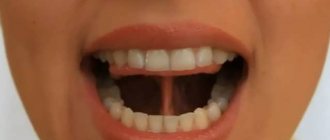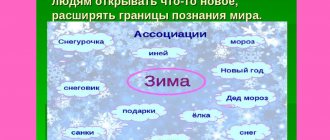Project “City of Letters” - all about the letter “M” for 1st grade
Project goal: To get acquainted with all the letters of the Russian alphabet and choose your favorite letter.
Draw and talk about her character, as well as behavior in the City of Letters, having learned about her from the works of the textbook “Literary Reading”. Make a letter layout, prepare a report for a speech and a presentation with illustrations. Project execution plan:
- My favorite letter
- Let's make a letter layout from cardboard.
- Character of the letter "M".
- Poems about the letter "M".
- Riddles about the letter "M".
- Text about the letter “M” for the Museum of Letters.
- An example of a finished presentation.
Report to the project
I chose the letter “M” for the Museum of Letters. Because she is my favorite. Various writers have said a lot of interesting things about this letter.
The word Mouse begins with the letter M, which denotes a rodent fleeing from a cat in V. Danko’s poem.
The Merry Masquerade was started by the letters in Sasha Cherny's poem.
The letter M is a consonant and cannot be sung.
But you can Moo it, as the chicken did in I. Gamazkova’s poem.
In S. Marshak's poem, the word Bear, who threatened to eat all the other passengers, begins with the letter M.
Also, the words Courage, Mom, Raspberry, and Ball begin with this letter.
MAGAZINE Preschooler.RF
Sounds "M" "M". Letter "M" "Food" Purpose: Systematization of children’s knowledge about the classification of food products. Introduce children to the mechanism of formation of the sounds “M”, “M”. Correctional and educational. Strengthen the ability to isolate sounds from words. Compare the articulation of the sound “M” with the articulation of the vowel sounds “A”, “O”, “U”. Introduce the term “consonant” sound. Learn to conventionally designate consonant sounds (hard voiced sounds - with a blue chip with a bell, soft voiced sounds - with a green chip with a bell). Correctional and developmental. Exercise children in dividing words into syllables. Continue to teach children to highlight the sounds “M”, “Мь” at the beginning, middle, and end of a word. Develop fine, gross and articulatory motor skills. Teach children diaphragmatic breathing, changing the strength and pitch of the voice. Develop phonemic hearing and perception. To form self-control of speech in children through oral, tactile-vibration and acoustic control.Correctional and educational. Formation of a positive attitude towards participation in the lesson. Equipment: Kar-karych, Sovunya, pictures of a machine, fly, poppy, ball, sounds for consonant voiced sounds, pencil cases, cut alphabet, demonstration material for the letter “M”, seeds, counting sticks, sponges. Integration: “Cognition”, “Socialization”, “Physical development”, “Safety”, “Health”. GCD move. I. A) Game with a ball “Think and answer” The game helps to activate verbs that are similar in meaning. Speech therapist (throws the ball to the child and asks questions). Are the cutlets boiled or fried? Tell me what else is being fried? Child. Fish, egg, potatoes. Speech therapist. Is the bread baked or stewed? Tell me what else they bake? Child. Pies, cakes, cookies. Speech therapist. Is the milk boiled or boiled? Tell me what else they cook? Child. Porridge, soup, compote, pasta. B) Game “Dividing words into syllables” (with sponges) Milk poppy coffee flour soup bun salt sour cream kefir sausage cheese fish juice sugar cake salad jelly C) D/i “Remember and name” Children must remember words that have the sound “ Oh" (sit down). Mule soup beech juice fluff Mol son bok buk kol Mal son bak som pas D) Facial massage Performing a massage jointly with a speech therapist Affectionate kitty licks Stroking movements Goat butts with small horns Tapping with fingertips Cat sharpens claws Rubbing movements along massage lines Affectionate kitty caressing Stroking movements
II. A) We know that there are sounds that can be pronounced and drawn out for a long time and loudly, without anything getting in the way in the mouth, there is no barrier - as such sounds are called - VOWELS. A U O B) There are sounds that are pronounced using the lips, teeth, and tongue. These are CONSONANT sounds. - Today we will get acquainted with one of the sounds, it is hidden in the words: MAC FLY MACHINE - What is the same sound we hear in the words - “M” - Say the sound “M”. When pronouncing the sound "M", does air flow freely? (No, the air meets an obstacle) - What obstacle does the air meet? (Lips get in the way) -If, when pronouncing a sound, the air encounters an obstacle, then this sound is called a consonant. — We denote hard consonant sounds with blue chips. C) Characteristics of the sound “M” - The sound “M” is a consonant, because when it is pronounced, the air encounters an obstacle. This sound is loud. Place your hand on the neck and say the sound “M”, you will feel the neck “trembling”. The sound “M” is hard and sonorous; we will denote it with a blue chip with a bell. Children characterize the sound “M”, based on the questions of the speech therapist: - Is the sound “M” a consonant or a vowel? Why? — Is the “M” sound voiced or unvoiced? Why? — Is the “M” sound hard or soft? - What color do we use to represent the sound “M”?
III. Physical exercise. Drink tomato juice, walk in place, eat carrots! Hands to shoulders, hands up. All the guys will put their hands on their belts, bend to the side. Strong and dexterous hands on their belts, squats. Flu, sore throat, scarlet fever - hands on the belt, jumping Everyone will drive away the vitamins! walking in place.
B) Work on developing breathing and voice. Inhale and as you exhale say M-M-M-M-M
IV. Riddle (PICTURE) They beat him with a hand and a stick - No one feels sorry for him. Why are they beating the poor guy? And for the fact that it is inflated... (ball) A) - Say the sound “M”. When pronouncing the sound “Мь”, does air flow freely? (No, the air meets an obstacle) - What obstacle does the air meet? (Lips get in the way) - Say the sounds “M” “M” alternately. Are your lips pursed with equal force? (When pronouncing the sound “M”, the lips are compressed more tightly.) This sound is called soft. — We denote soft consonant sounds with green chips. B) Characteristics of the sound “M” - The sound “M” is a consonant, because when it is pronounced, the air encounters an obstacle. This sound is loud. Place your hand on the neck and say the sound “M”, you will feel the neck “trembling”. The sound “Мь” is soft, sonorous, we will denote it with a green chip with a bell. Children characterize the sound “M”, based on the questions of the speech therapist: - Is the sound “M” a consonant or a vowel? Why? — Is the sound “Мь” voiced or unvoiced? Why? — Is the sound “M” hard or soft? - What color do we use to indicate the sound “Мь”?
V. Didactic game “Stone - cotton wool” A mouse is scratching on the floor, A brown bear is sleeping in a den, This bear is very cute, Only he did not wash his paws. The mouse ran into the hole, the bear went to sleep in the den, the boy is small, but very cute. He washed his hands with water.
VII. Introducing the letter. Characteristics of the letter "M". 1. Showing the letter by a speech therapist. The letter “M” with two humps, Like a camel - see for yourself.
We must take two sticks diagonally, and, as everyone understands, the letter “M” appears. 2. In individual cash registers, find the letter (large and small). Review and answer the questions. - How are large and small letters similar? (they are the same shape) - What is their difference? (they differ in size) - What elements does the letter “M” consist of? — What objects does the letter “M” resemble? (for a donut, a hoop, a steering wheel, a wheel) - House of Consonants. — Trace the letter “M” with your finger, print it with your finger on the table, in the air (I do it on the board), lay it out with seeds.
RESULT. REFLECTION.
| Next > |
Lesson notes - Sound and letter “M” for preschoolers with OHP
Synopsis of a frontal speech therapy session to prepare for literacy training for older children with special needs development.
Topic: SOUND AND LETTER “M”
TASKS:
Correctional and educational:
- learn to determine the first consonant sound, hardness - softness, sonority - dullness, position of sound in a word (beginning, end);
- consolidate the skills of clear pronunciation of the sound M, the concept of “syllable”;
- practice sound analysis and synthesis of syllables, dividing words into syllables;
- activate your verb dictionary.
Correctional and developmental: develop auditory attention, phonemic perception, articulatory and general motor skills, visual-motor coordination, memory, thinking.
Correctional and educational: cultivate a positive attitude towards classes; the ability to control one’s own speech; develop the skill of cooperation, the ability to listen to the interlocutor; cultivate respect for each other.
EQUIPMENT: pictures: girl Masha, cat Murka, flowers - daisies, poppies, tulips, asters, bells; semolina porridge and milk, pictures with and without sound M, capital letter M, mosaic, red and blue chips, sound track.
PROGRESS OF THE CLASS:
1. Go through the audio tracks, naming each vowel letter.
Today I want to tell you one amazing story about one amazing girl Masha. And she was amazing because every day she invented a new game for herself. So today Masha woke up, washed her face, did exercises and didn’t forget about her lips and tongue.
2. Articulation gymnastics.
a) Frogs smile - they pull their lips straight to their ears (“Smile” with closed lips); b) I imitate an elephant - I pull my lips with my trunk; c) The tongue is wide, smooth - it turns out to be a “scapula”
Today Masha thought: “This is the first sound I’ll hear, and I’ll be friends with it all day long.” Suddenly the cat Murka came running and started talking to Masha: “Mu-u-u-r-r..” Masha smiled - that means today I’m playing and making friends with the sound ... (which one, guys?) with the sound M.
3. Articulation and characteristics of the sound M
The lips are closed, the teeth are slightly open, the tongue lies calmly below. Consonant (there is a barrier - lips), firm, sonorous.
Masha went to the kitchen. Mom was preparing breakfast there. What kind of porridge did your mother cook, do you think: buckwheat, semolina or rice? Why? Masha went to the garden where the flowers grow, and sang songs along the way:
4. Reproduction of syllable rows: we-ma-mo, mo-we-mu, we-mo-ma... (everyone in turn helps Masha sing the song)
There were many flowers growing in the garden (pictures on the floor), but Masha chose flowers only with the sound M ( asters, daisies, bells, poppies, tulips ).
– What flowers should I pick? Why? (children's answers) What is a bouquet of poppies called if a bouquet of tulips is called a tulip bouquet? From poppies? ( poppy ), from daisies? ( chamomile ). Masha returned to the kitchen with flowers. And on the table there was already semolina porridge and milk . What was on the table? (semolina porridge and milk). Masha laughed: “Mommy, what a great fellow you are, you help me in my game.” - Why did Masha say that? Masha ate everything and said thank you. Now we will show Masha how we can play with sounds.
5. Sound analysis and synthesis of syllables.
Mark the syllables with chips: ma, om, mu.
Game "Live Sounds"
Masha took the book and began to look for pictures with the sound “m”. We also have pictures, take them under the chairs.
6. D/i “Find a picture with the sound “m.”
Determine where the sound M is at the beginning or end of the word. The one with the pictures with the sound M at the end, at the beginning, the pictures without the sound M will come out.
Let's divide the words you chose into syllables:
7. D/i “Divide the words into syllables” (children’s choice).
mu-ha - clap, ma-shi-na - stomp, mu-ho-mor - jump.
When dad returned from work, Masha talked about pictures with the sound “m” that she had been looking for all day. She also came across pictures - a fly , a car , a mouse . Dad asked what these objects do?
8. D/i “Choose an action word”
A fly flies, buzzes, bothers, sits, crawls... A car drives, stops, drives, drives in, drives out... A mouse squeaks, makes noise, gnaws, rustles, runs, jumps...
9. Introducing the letter.
Guys, we remember that we hear and pronounce sounds, but we see, read and write letters. So the sound “m” has its own letter “M”.
Stick and stick, Between them is a tick. And now it’s clear to everyone. The result is the letter “M”. Children lay out a letter from the mosaic.
10. Summary of the lesson.
What sound was there in class today? Is it a vowel or a consonant? Voiced or voiceless? Hard or soft?
PHYSICAL MINUTE (in the middle of the lesson) We use our hands - clap-clap-clap (6 times), We use our feet - stomp-stomp-stomp (6 times). Let's knock with our fists (6 times), turn around and remain silent (cover your mouth with your hand).
Anzhero - Sudzhensky urban district Municipal budgetary preschool educational institution combined type kindergarten No. 42 Author of the material: teacher-speech therapist: Levina Natalya Vladimirovna
Also on topic:
Summary of speech therapy lesson topic: Sounds M - M
Test "Letter M"
In order to develop phonemic awareness, it will be useful to listen to words containing M at the beginning, middle and end of the word. I prepared a small test for this case.
Ask your parents to read each word out loud to you and try to determine where M is pronounced firmly, where softly, and determine the place of the sound M in the word: beginning, middle, end.


